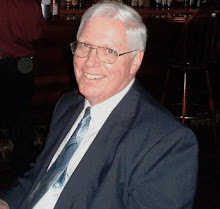Grand Canyon day one.
04 October 2010
Canyon De Chelly National Monument
I had a great day touring the north and south rims of Canyon De Chelly National Monument. The canyon is not in the same league as the Grand Canyon NP or even Bryce Canyon NP. The rims are only 600 -700 feet above the floor of the canyon. Still it is a beautiful place and not heavily visited by other tourists. The floor of the canyon is still occupied and farmed by the Navajos. The canyon floor is NOT part of the National Monument. What is special about Canyon De Chelly is the cliff dwellings built by the ancient Anasazis who were the original farmers of this land. Most of the overlook stop areas along the canyon have Navajos in the parking lots selling handmade jewelry etc.
A View of some safe rooms two-thirds the way up the canyon walls on the North Rim of Canyon De Chelly. Archeologists believe that the Anasazis used them for the women and children if they were attacked while the men were away hunting.

A closeup photo of the same safe room cliff dwellings
A distance shot of some more Anasazi adobe ruins from the other side of Canyon De Chelly National Monument.
A closeup of the same adobe ruins shown above.
And even closer closeup photo of the same ruins. Note the petrogylphs on the canyon wall below the adobe ruins.
Spider Rock in Canyon De Chelly is considered sacred by the Navajo. It is named for Spider Women who the Navajo believe taught them how to weave. They believe she lives on top of the spire.
While it is not visible from this view from the westernmost section of the canyon rim, it is obvious where the creek is.
Views of the canyon floor in the next two photos.
A series of three photos showing Anasazi adobe ruins at different levels of magnification.
30 September 2010
29 September 2010
Navajo Nation and Monument Valley
You might think the Navajos are a little arrogant or pretentious calling their reservation a "nation." Please realize that the "big rez" as some Navajo call it, is bigger than the state of West Virginia, and when you include all the satellite Navajo reservations in Arizona, Utah, Colorado, and New Mexico, Navajos are justified calling it a "nation."

In the Colorado portion of the "big rez," sunflowers lined the road like the ones above. It didn't stay that way for long as the land became more arid and desert like in Arizona.
Lots of blooming scrub brush, though.
The above picture with the flat rock precariously balanced gives the nearby town of Mexican Hat, Utah its name. By the way, Mexican Hat is the last place you can buy beer or wine before entering the Navajo Nation. For obvious reasons to all of us, the sale of booze is illegal in the Navajo Nation.
A thin ribbon of green outlines a creek in Navajo land where the farming is sparse.
This is the smallest butte I saw on Navajo Nation land. The land around it is absolutely flat and the rock juts up through it in a near perfect miniature of some the area's other "monuments."
I spent all my time today driving around and in Monument Valley. If you have ever enjoyed some of the classic western movies such as the ones directed by John Ford and those starred in by John Wayne, this is the location they used for the movies. The land is just plain awesomely beautiful.
I find the spindly rock spires of Monument Valley fascinating. The colors of the mesas and buttes are just beautiful. Hard for me to write prose worthy of the landscape.
If you look closely, you can see a "keyhole" in this butte known as the "west mitten."
A"view" of the Navajo Tribe's Luxury Resort, The View, from the valley floor . I agree that it must be a world class luxury resort since the hotel rooms I priced start at $340 per night. Much too luxury for me. I must agree, though, that every room has the best view of the most famous "monuments" in Monument Valley. If you have ever seen the complex the Navajos have built to attract tourists like me, then you know these Indians are making a lot of money.
Merrit Butte in the center; East Mitten Butte to the right, West Mitten to the left.
West Mitten Butte in the center of this photo
The road to (and from) Hell shown above is a story onto itself. I would never drive it again.
Subscribe to:
Comments (Atom)


















b.jpg)
b.jpg)
b.jpg)
b.jpg)









































